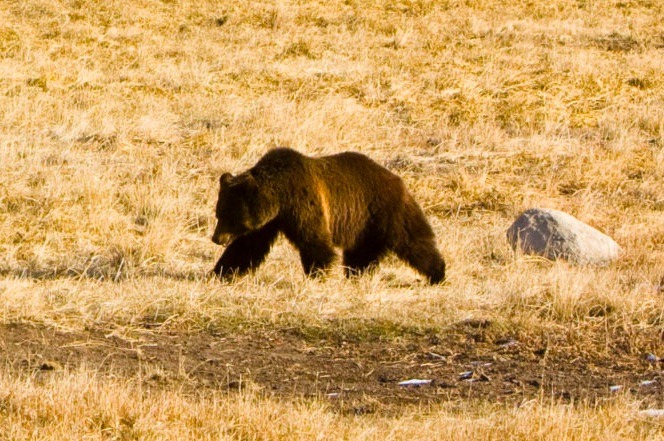The Symbolic Plight of Yellowstone’s Grizzly Bear
Driving around Montana, grizzly bears are everywhere — but in symbolic, rather than corporeal, form. As the state animal, they’re often seen as mascots, and businesses — from restaurants to optometrists’ offices — have them on their signage.
The grizzly bear was listed as threatened under the Endangered Species Act in 1975, when human development and hunting caused their numbers in the Greater Yellowstone Ecosystem to plummet. After dropping to just 136 bears, recent projections place their numbers there at roughly 700. But it isn’t all good news for the grizzly: Federal authorities now want them delisted.

Grizzly bear numbers have risen since they became protected under the Endangered Species Act, but should they be delisted?
As the New York Times recently noted, the U.S. Fish and Wildlife Service is advocating removal of the bear, a proposal that’s been criticized by environmentalists as a political move, designed to appease ranchers.
“Many Westerners vehemently oppose the federal authority represented by the Endangered Species Act,” The Times wrote, “some ranchers say bears are preying on their herds more frequently, and some hunters are eager for a trophy,”
According to The Guardian, if the bears are delisted, in-state hunters would be offered $50 licenses to shoot them, while out-of-state hunters would pay $1,000. A group of scientists, headed by conservationist Jane Goodall, is asking the federal government not to reduce protections, disputing the 700 grizzly bear figure and saying that the animals still face many challenges to survival, including habitat loss and a reduction in food supply.
When the Fish & Wildlife Service first announced the proposed delisting in March, it cited the recovery of the grizzly as a success. I was told a similar thing last year, during a long reporting trip in Montana. In his office at the University of Montana in Bozeman, Chris Servheen, the coordinator of the federal government’s Grizzly Bear Recovery Program, told me, repeatedly, that the bears had to be delisted for the good of the Endangered Species Act.
“We need some success stories,” he told me at the time.
The problem is, by this definition of success, the Fish & Wildlife Service isn’t doing very well. If the goal of the Endangered Species Act is to rebuild populations and swiftly graduate those species by removing them from the list, then the act has been relatively unsuccessful. Currently, there are 2,258 plant and animal species — both domestic and foreign — listed as “endangered” or “threatened.” Since the act was signed in 1973, 63 species have made it off the list, only 34 of which are classified as “recovered.” That doesn’t make for a very good graduation rate.
And if you look at the species that have been delisted, very few of them are the kind of charismatic megafauna which make for stirring publicity. The bald eagle, arguably the most well-known success story of the Endangered Species Act, was listed under a precursor act in 1967, when the population had dwindled to just 417 nesting pairs. It was removed from the list in 2007 and now there are an estimated 10,000 nesting pairs across the United States. Other recovered species are far less popular, like the gray wolf, which was delisted in 2011 in response to widespread protests from ranchers and locals who argued that the growing numbers of wolves were dangerous.
The Fish & Wildlife Service recently gained a more photogenic graduate: The Louisiana black bear, both the state animal of Louisiana and the model for “Teddy bear” toys. The black bear was classified as “recovered” in March after more than two decades on the Endangered Species list. Still, the grizzly bear would be an even more prominent success.
But judging the Endangered Species Act by its graduation rate is a narrow definition of success. When the act was first signed into law, it was, foremost, a last-ditch assignment of guardianship, to preserve the ecosystems where endangered and threatened species live.
By that definition, which focuses on conservation, the Endangered Species Act has been a resounding success. Only 10 species given protections by the law have ever become extinct, and a number of articles show a majority of the listed species are either stable or meeting the growth designated by their recovery plan.
That’s one of the reasons delisting the Yellowstone grizzly bear is such a controversial subject. It’s helping us define what success in wilderness preservation really means, and that’s no small feat.










